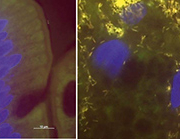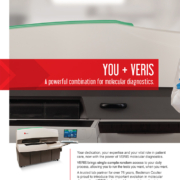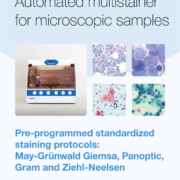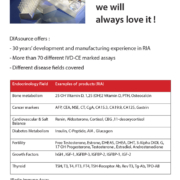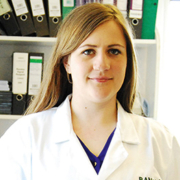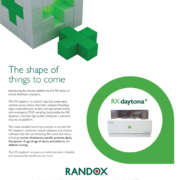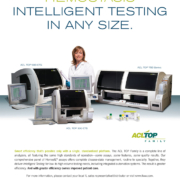Chronic kidney disease: an ‘invisible epidemic’ ?
A growing challenge for nephrologists is to quickly identify patients with chronic kidney disease (CKD). Experts believe there is now “coherent, undisputable evidence” that timely treatment of CKD can delay the onset of end-stage renal failure (ESRF).
The challenge of timely diagnosis
Several studies suggest that early identification and management of CKD can reduce the risk of kidney failure progression and halve co-morbidities such as cardiovascular disease. The latter is a significant achievement on its own, since cardiovascular complications are estimated to increase mortality in CKD patients by 2-4 times over that of the general population.
Nevertheless, early diagnosis of CKD has not proven to be easy. Chronic kidney disease tends to develop slowly, with few evident symptoms. As a result, most patients seek clinical expertise only after the disease has advanced to a stage where dialysis becomes unavoidable.
Epidemiological data limited
Confounding the problem is a lack of epidemiological data. In the US, the Centers for Disease Control (CDC) can only estimate that “more than 20 million people may have CKD.”
The picture is even less encouraging in Europe. In a first-of-its-kind effort in 2010 to explore what they labelled a “silent epidemic,” Dutch and Italian researchers were “struck by the fact that epidemiological data for CKD existed only in a tiny minority of European countries.” More puzzling was official data from the European Commission or the bulk of EU Member States, which “did not even mention CKD as an issue of public health concern.”
Attempts to establish aggregated CKD data in Europe have led to mixed results. The ambitious EUGLOREH (Status of Health in the European Union) survey established prevalence rates of (higher risk) Stages 3-5 CKD ranging from 3.6% in Norway to 7.2% in Germany, but little about earlier Stages (1 and 2) where treatment best delays progression.
Prevalence of Stages 3-5 CKD was similar for males and females in Germany and Italy, but higher for females in other countries – Belgium, England, Iceland and Norway. In countries for which data was available, prevalence also rose with age.
However, EUGLOREH underlined the total lack of time-trend epidemiological data in Europe, unlike the US where the so-called NHANES III and IV surveys showed prevalence of Stages 1-5 CKD rising from 14.5% in 1988-94 to 16.8% in 1999-2004, while that of Stages 3-5 remained near unchanged, at about 6%.
Delaying dialysis
Recent clinical practices, which advise delaying the onset of dialysis as far as possible, are driving the need for early identification of CKD. In 2003, ‘Kidney International’, the Official Journal of the International Society of Nephrology, stated that “dialysis delayed is death prevented.”
The authors noted that hundreds of thousands of renal failure patients lived in developing countries with inadequate resources or infrastructure; however, many Western patients too were unsuitable for dialysis, “because of age, frailty, or a co-morbid illness with poor prognostic outcome.”
Costs of CKD
The financial impact of CKD is high. In the US, the cost of CKD and its co-morbidities in the pre-ESRF phase are estimated to be as much as $26,000 per patient each year.
Delaying the onset of ESRF provides significant, additional benefits. For example, Italy spends 1.8% of its total health care budget on ESRF patients, who represent only 0.083% of the general population. In the UK, ESRF accounts for 2% of health spending.
The situation in the US is dramatic, with kidney treatment accounting for 24% of Medicare spending, higher than congestive heart failure.
Testing for CKD
Typically, detection and monitoring of CKD requires both urine and blood tests in the laboratory. The former typically focus on kidney function and the latter on damage, according to the US National Institutes of Health (NIH). Key markers for CKD are abnormal urinary levels of albumin (albuminuria) and other proteins (proteinuria), along with a persistent reduction in the glomerular filtration rate (GFR). Variations in urine concentration are corrected by urine albumin-to-creatinine ratio (ACR) or protein-to-creatinine ratio (PCR) on a spot specimen. However, there is considerable debate about the clinical and cost-effectiveness evidence of ACR versus PCR.
So far, CKD testing has largely been driven by diabetes patients, with best practices based on care standards from professional bodies such as the US National Kidney Foundation, the American Diabetes Association and the National Institute for Health and Care Excellence (NICE) in the UK. At-risk groups considered to be typical targets for screening consist of patients with hypertension, cardiovascular disease or a family history of kidney failure. In the US, the CDC estimates that about “1 of 3 adults with diabetes and 1 of 5 adults with high blood pressure has CKD.”
Limitations to screening
With some exceptions, testing urine is not recommended in the general population. In the US, the NIH explains that the “benefit of CKD screening in the general population is unclear.”
The reasons for this restraint are also practical. Albumin levels fluctuate over the day due to metabolism and diet. As a result, urine samples are collected on a random, 4-hourly, or overnight basis. If abnormalities are indicated, re-confirmation is required via a timed, 24-hour collection cycle, accompanied by the labelling and refrigerated storage of the samples. All this clearly poses logistical challenges for large scale CKD screening.
Secondly, any mass screening would clearly use colour-changing dipsticks, the first point of call for urine tests. Though the National Kidney Foundation considers dipsticks satisfactory for a first screening, it warns clinicians to be especially cognizant of false negative results, and specifies the need for lab analyses to quantify urine PCR and ACR ratios. Indeed, while ACR of over 30 mg/g is considered to indicate CKD, the sensitivity level of dipsticks begins at 300 mg/g.
The only alternative to urine is a blood sample, but this too has evident limitations as a mass screening tool for CKD.
Expanding screening: recent developments
Nevertheless, there is growing evidence that larger-scale screening for CKD is likely in the future.
In 2005, Dutch researchers sought to address the challenge of a 24-hour urine collection cycle. They reported that a level of about 11 mg/L urinary albumin concentration (UAC) in a single spot morning urine sample could identify microalbuminuria, and do this as effectively as ACR. They suggested the above as a cut-off point for requiring subsequent urine sample collections, to avoid “huge numbers of individuals” having to undergo “the cumbersome procedure of a 24-hour urine collection” in any mass screening program.
In 2008, the UK’s NICE formally enlarged the scope of testing. It recommended that apart from diabetes, screening for CKD be undertaken in patients with hypertension, cardiovascular diseases, structural renal tract disease, renal calculi or prostatic hypertrophy and multisystem diseases such as systemic lupus erythematosus. The list extended to people with a family history of Stage 5 CKD or hereditary kidney disease.
In its guidelines, NICE also attempted to come to grips with vexing questions on CKD markers such as albuminuria and proteinuria, and the selection and sequencing of tests. The Institute however left open room for further interpretation. Its consensus recommendation was that “ACR should be the test of choice” , but also said there would “often be good clinical reasons for subsequently using PCR to quantify and monitor” proteinuria.
In 2012, the Australasian Proteinuria Consensus Working Group took what may be one of the biggest steps so far to scale up screening. Based on a retrospective longitudinal cohort study of 5,586 CKD patients, it extended the UK NICE screening envelope to include obesity and smoking, and “strongly” advocated targeted opportunistic testing for CKD risk in “all adults attending an appointment with their health care practitioner”. The Working Group also concluded that ACR from a morning (or random) spot urine sample was as good as PCR and 24-hour urinary albumin and protein measurements, and recommended testing for albuminuria rather than proteinuria in individuals at risk of CKD.
The group advised “all pathology laboratories in Australia” to implement its recommendations as part of an “integrated national approach to CKD detection.”
The UK: A ‘World Leader’ in early detection of CKD
Although the Australian recommendations appear to be much more explicit than the NICE guidelines, the UK has ensured that CKD is incorporated into its wider Quality and Outcomes Framework (QOF). As a result, GPs are now rewarded based on how well they identify and manage patients with CKD. CKD is given 27 points in QOF, alongside 9 points for diabetes related to kidney disease. This is considered to provide significant support for the Renal National Service Framework (NSF), which aims to minimize the impact of kidney disease in its early stages.
Indeed, the EUGLOREH report mentioned previously considers the CKD-directed steps in the Quality and Outcomes Framework to have made the UK “a world leader in this field.”
Telediagnosis may offer breakthrough in mass CKD screening
Meanwhile, a breakthrough in the US could remove the final barriers to a true mass screening program for CKD.
In August 2013, researchers from the University of California at Los Angeles (UCLA) announced they had developed a compact, field-portable device to conduct albumin tests and transmit data via smartphone, thus reducing the need for “frequent office visits by people with diabetes and others with chronic kidney ailments” or the use of “bulky and costly benchtop urine analysers” which limit testing and diagnosis to laboratory settings. The new system projects beams of visible light through two attached fluorescent tubes, one of which contains a control liquid and the other a urine sample mixed with fluorescent dyes. The smartphone camera captures the fluorescent light after it passes through an additional lens.
The device measures albumin concentration to less than 10 micrograms per millilitre, which its inventor states is “more than 3 times lower than the clinically accepted normal range.” It weighs less than 1 kg and is estimated to cost $50 to $100, with tests taking about 5 minutes.



